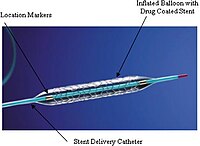
Photo from wikipedia
Surface electrode arrays are mainly fabricated from rigid or elastic materials, and precisely manipulated ductile metal films which offer limited stretchability. However, the living tissues to which they are applied… Click to show full abstract
Surface electrode arrays are mainly fabricated from rigid or elastic materials, and precisely manipulated ductile metal films which offer limited stretchability. However, the living tissues to which they are applied are non-linear viscoelastic materials which can undergo significant mechanical deformation in dynamic biological environments. Further, the same arrays and compositions are often repurposed for vastly different tissues rather than optimizing the materials and mechanical properties of the implant for the target application. By first characterizing the desired biological environment, and then designing a technology for a particular organ, surface electrode arrays may be more conformable, and offer better interfaces to tissues while causing less damage. Here, the various materials used in each component of a surface electrode array are first reviewed, and we then describe electrically active implants in three specific biological systems: the nervous system, the muscular system, and skin. We last offer considerations for fabricating next-generation surface arrays that overcome current limitations. This article is protected by copyright. All rights reserved.
Journal Title: Advanced materials
Year Published: 2021
Link to full text (if available)
Share on Social Media: Sign Up to like & get
recommendations!